Celebrating 75 Years of Nancy Drew
The stars were in alignment at Nancy Drew’s creation in 1930 since several factors combined to produce a bestseller. First there was the storytelling genius of Edward Stratemeyer, his timely adaptation of the mystery genre for juveniles, and the marketing power of his syndicate. There also existed a market in the early 20th century for a girls’ series with a strong heroine with style, courage, and independence since most books for girls at that point featured dependent and obedient heroines.
Another crucial element for Nancy Drew’s success was the selection of Mildred Wirt Benson as the ghostwriter for the series. A final winning touch was Stratemeyer’s choice of Russell Tandy to illustrate the dust jackets and internal illustrations for the series. The classic fashionable Nancy he created did much to add to the appeal of these books. That Harriet Stratemeyer Adams and Edna Stratemeyer Squier were willing to take over the running of the Stratemeyer Syndicate after Edward Stratemeyer’s death so soon after the first Nancy Drews were published also was important in the continued success of the Nancy Drew Mystery Stories.
Themes in Nancy Drew
Contributing to the appeal of the Nancy Drew series is the predictability of always finding certain elements present in the stories. Although she encounters danger in every book, we know Nancy will always solve the mystery and restore order. We know Nancy will use her wits to discover and interpret clues to solve the mystery. We know she will fearlessly do whatever is necessary to catch the villain without thought of her own safety, whether it involves climbing up the side of a house on a ladder in the middle of the night, driving in a storm on a winding road, or secretly spying on suspicious behavior. Illustrations from the Nancy Drew books reinforce some of these common occurrences.
Left Image: Keene, Carolyn. The Sign of the Twisted Candles. New York: Grosset & Dulap, 1933. [Facsimile edition: Bedford, MA: Applewood Books, 1991.]
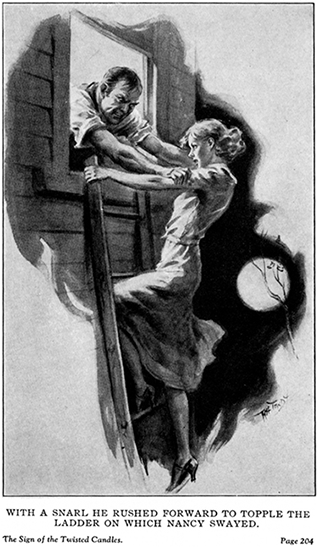
Little Blue Coupe
Nancy’s car figures prominently in her adventures, and her excellent driving skills are stressed in many of the mysteries. In The Bungalow Mystery, Nancy’s car is practically a co-heroine. Her expertise in driving is repeated numerous times, and her roadster seems to have a personality of its own.
“The rough forest road held Nancy to a slow pace, but when she reached the lake thoroughfare she stepped on the accelerator, and the little car began to purr like a contented cat.”
p. 157, The Bungalow Mystery
“The little blue car fairly roared down the road as though it, too, were eager to overtake Stumpy Dowd.”
p. 160, The Bungalow Mystery
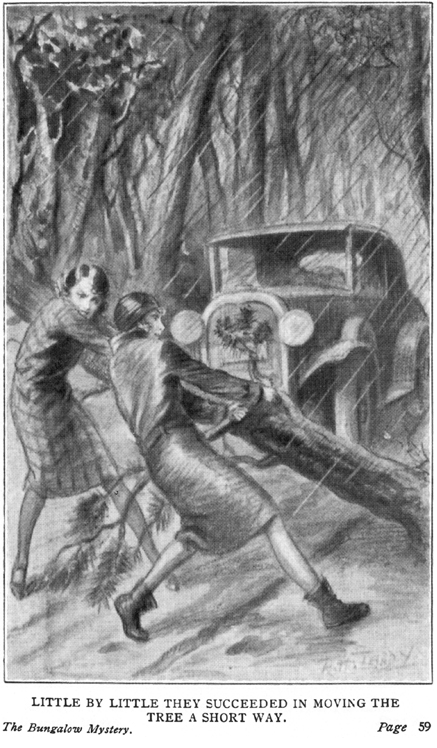
Nancy’s driving is crucial in the climatic road race to catch the villain Stumpy Dowd in The Bungalow Mystery. Only Nancy sees the warning sign for an upcoming sharp curve; Stumpy is oblivious of the danger and waves tauntingly at Nancy. As a result, he drives off a cliff. Nancy saves his life by pulling him from the wrecked car before it is consumed with fire.
Keene, Carolyn. The Bungalow Mystery. New York: Grosset & Dunlap, 1930.
[Facsimile edition: Bedford, MA: Applewood Books, 1991.]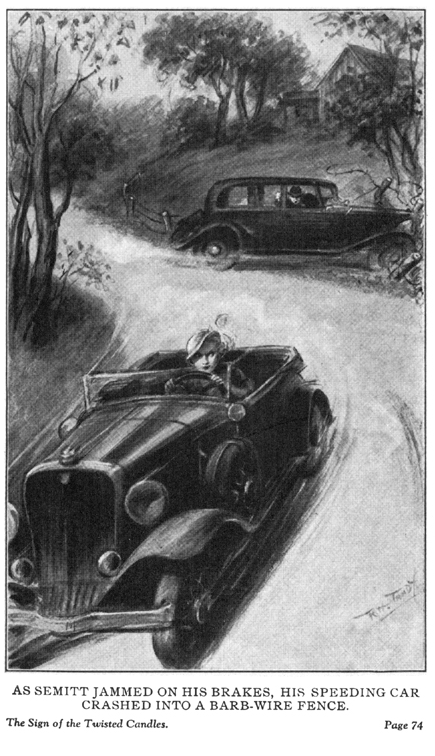 Nancy Drew’s car gives her independence and mobility. She can hop in her car and go anywhere she desires at a moment’s notice. Not only are her driving skills amazing, but she can also change a tire, make other repairs, and move trees or other obstacles out of the car’s path.
Nancy Drew’s car gives her independence and mobility. She can hop in her car and go anywhere she desires at a moment’s notice. Not only are her driving skills amazing, but she can also change a tire, make other repairs, and move trees or other obstacles out of the car’s path.
Keene, Carolyn. The Sign of the Twisted Candles. New York: Grosset & Dunlap, 1933.
[Facsimile edition: Bedford, MA: Applewood Books, 1991.]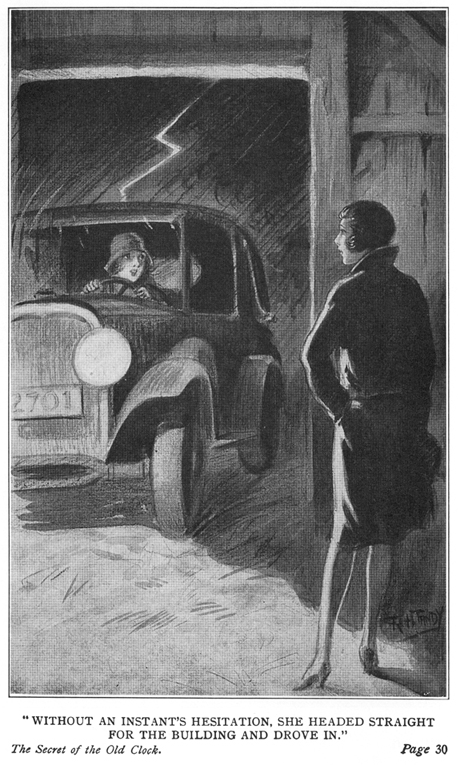 Nancy Drew drives a blue roadster in the early volumes. In the 1970s, it becomes a blue convertible. Next it was a blue Ford Mustang. Now it is a blue Hybrid!
Nancy Drew drives a blue roadster in the early volumes. In the 1970s, it becomes a blue convertible. Next it was a blue Ford Mustang. Now it is a blue Hybrid!
Keene, Carolyn. The Secret of the Old Clock. New York: Grosset & Dunlap, 1930.
Caught!
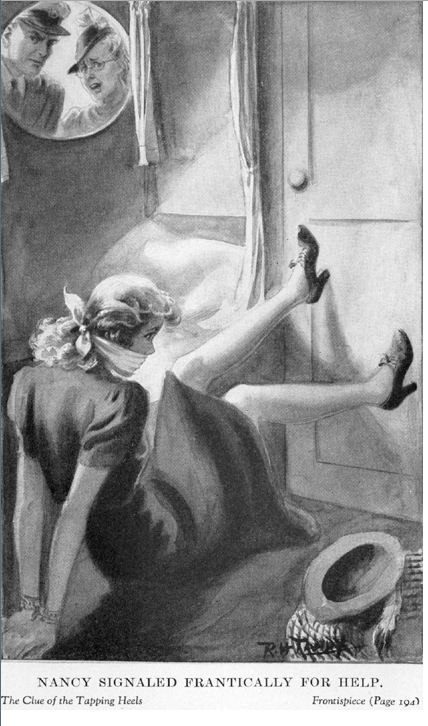 Nancy Drew becomes trapped in a closet, cellar, bedroom, or tower by the villain in nearly every mystery. She is amazingly resourceful at getting out of these situations and often escapes without having to be rescued.
Nancy Drew becomes trapped in a closet, cellar, bedroom, or tower by the villain in nearly every mystery. She is amazingly resourceful at getting out of these situations and often escapes without having to be rescued.
Keene, Carolyn. The Clue of the Tapping Heels. New York: Grosset & Dunlap, 1939.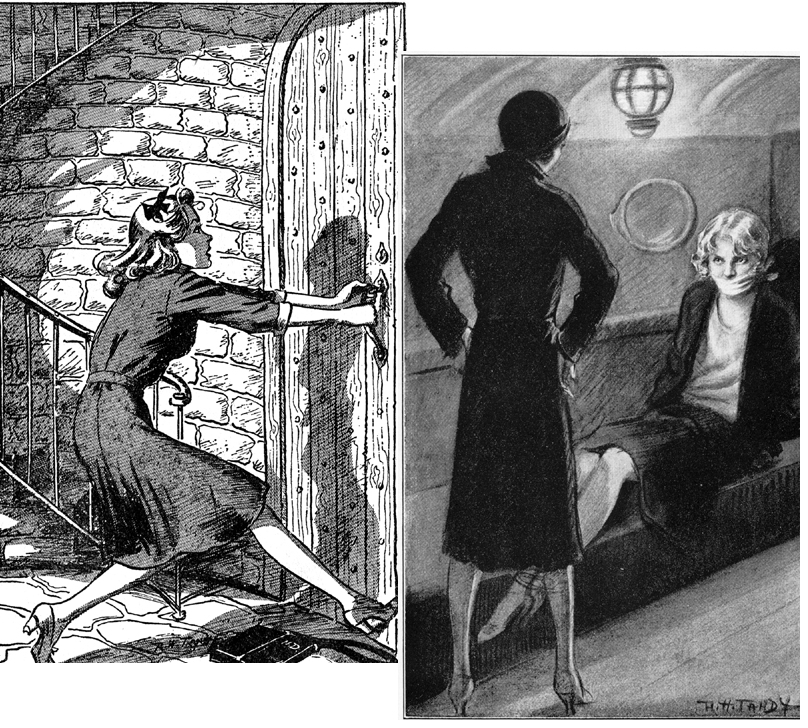 In The Secret of the Old Clock, she is locked in a closet by robbers; in The Bungalow Mystery, she is tied up and trapped in a cellar to starve; and in The Secret at Shadow Ranch, she is locked in a tack room.
In The Secret of the Old Clock, she is locked in a closet by robbers; in The Bungalow Mystery, she is tied up and trapped in a cellar to starve; and in The Secret at Shadow Ranch, she is locked in a tack room.
Keene, Carolyn. The Clue in the Crumbling Wall. New York: Grosset & Dunlap, 1945.
Keene Carolyn. The Mystery at Lilac Inn. New York: Grosset & Dunlap, 1930.
[Facsimile edition: Bedford, MA: Applewood Books, 1994.]
Look! A Clue
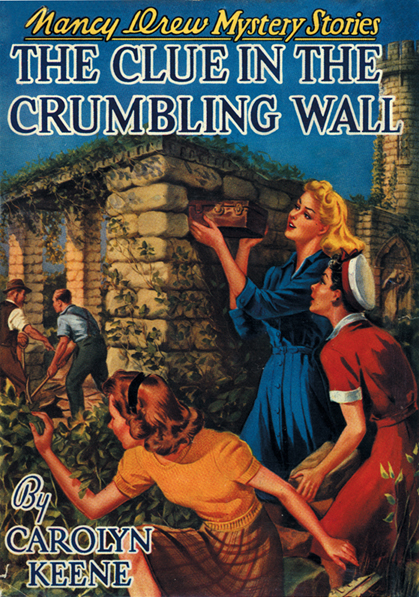 Most Nancy Drew mysteries involve finding a missing treasure; all rely on the importance of recognizing and following clues. Objects such as old clocks, twisted candles, broken lockets, brass-bound trunks, jewel boxes, diaries, and letters are important clues that sometimes contain the treasure.
Most Nancy Drew mysteries involve finding a missing treasure; all rely on the importance of recognizing and following clues. Objects such as old clocks, twisted candles, broken lockets, brass-bound trunks, jewel boxes, diaries, and letters are important clues that sometimes contain the treasure.
Keene, Carolyn. The Clue in the Crumbling Wall. New York: Grosset & Dunlap, 1945.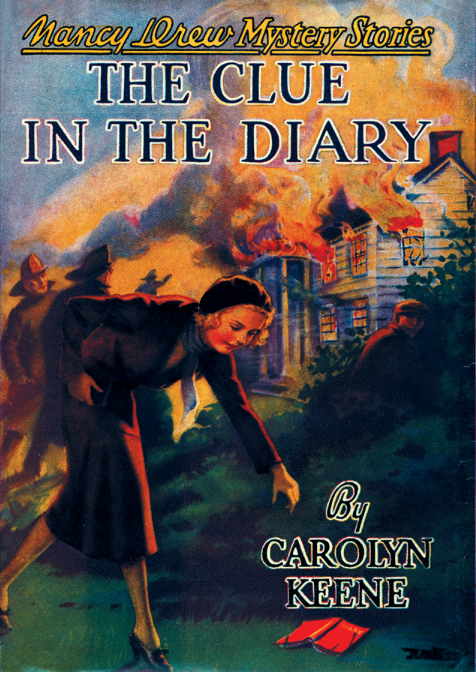 “‘Perhaps I’ve stumbled upon a clue!’ Nancy thought excitedly.”
“‘Perhaps I’ve stumbled upon a clue!’ Nancy thought excitedly.”
(The Clue in the Diary, p. 15)
Keene, Carolyn. The Clue in the Diary. New York: Grosset & Dunlap, 1932.
Climbing
 Nancy Drew thinks nothing of danger when she is on a hot case. She often climbs a ladder on the side of a house to find a villain or a victim or to pursue a clue.
Nancy Drew thinks nothing of danger when she is on a hot case. She often climbs a ladder on the side of a house to find a villain or a victim or to pursue a clue.
Keene, Carolyn. The Hidden Staircase. New York: Grosset & Dunlap, 1930.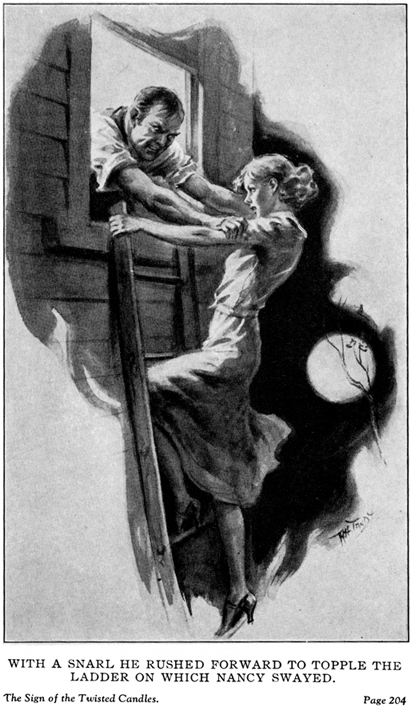 She can often be seen scampering up ladders in the middle of the night (and there is always a full moon); but this doesn’t faze Nancy!
She can often be seen scampering up ladders in the middle of the night (and there is always a full moon); but this doesn’t faze Nancy!
Keene, Carolyn. The Sign of the Twisted Candles. New York: Grosset & Dunlap, 1933.
[Facsimile edition: Bedford, MA: Applewood Books, 1991.]
Sleuthing
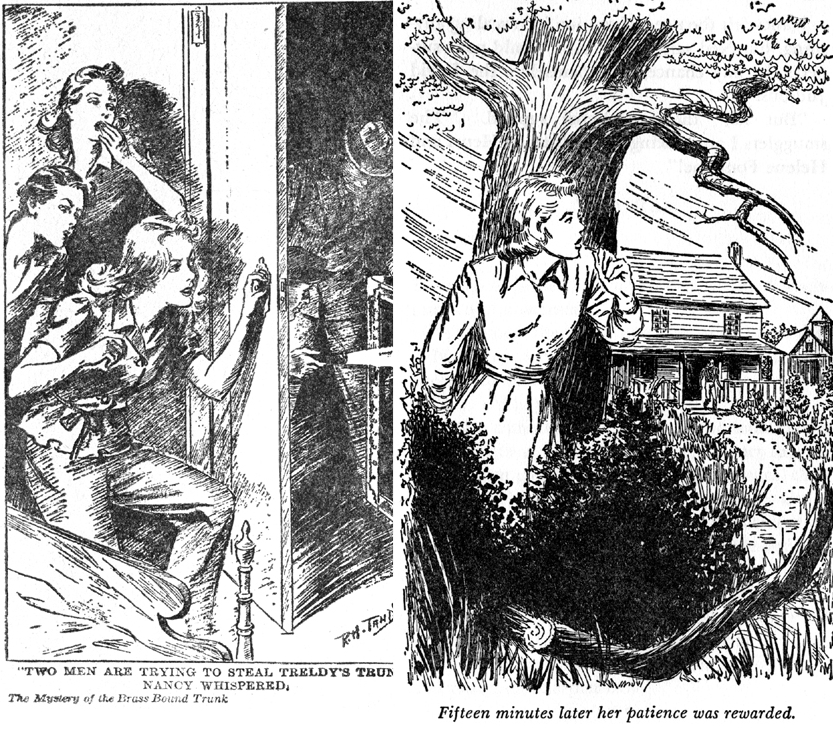 Nancy often observes suspicious behavior from behind a tree or wall. She is adept at figuring out where something suspicious might be happening.
Nancy often observes suspicious behavior from behind a tree or wall. She is adept at figuring out where something suspicious might be happening.
Keene, Carolyn. The Mystery of the Brass Bound Trunk. New York: Grosset & Dunlap, 1940.
Keene, Carolyn. The Scarlet Slipper Mystery. New York: Grosset & Dunlap, 1954.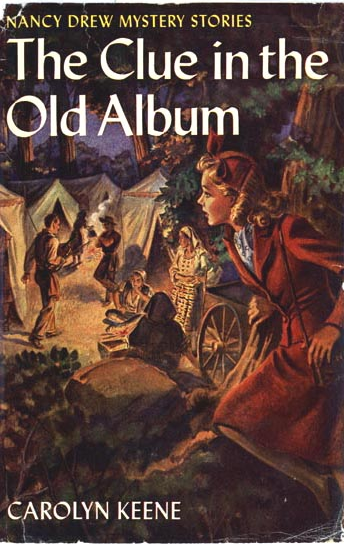 Sometimes she relies on her instincts, but often she uses clues or deduction to determine where to lie in wait. She is fearless about rushing to a hideout to determine what the villain is up to.
Sometimes she relies on her instincts, but often she uses clues or deduction to determine where to lie in wait. She is fearless about rushing to a hideout to determine what the villain is up to.
Keene, Carolyn. The Clue in the Old Album. New York: Grosset & Dunlap, 1947.

